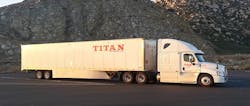The inclusion of trailers in the next round of greenhouse gas (GHG) emissions standards jointly announced by the Environmental Protection Agency (EPA) and National Highway Traffic Safety Administration (NHTSA) is adding a layer of complexity for everyone involved in meeting the new standards.
And that includes fleet executives, who will be responsible for finding the money to pay for equipment and, quite possibly, new technologies needed to meet the Phase 2 standards, which will generally result in a 24% reduction in carbon dioxide and fuel consumption of tractor-trailers.
Those same fleet managers, though, will want to see some fleet benefits from these rules. EPA says the rules will cut fuel costs for the industry by $170 billion, and that will certainly be money added to the budgetary bottom line. But is there more, and what can fleet executives do to unlock that additional value?
The future of fuel economy
Click the links for stories on:
GHG Phase 2: Taking the next step
Engines: Power and efficiency
Trucks: Match game
Trailers: Expecting more
In 2007, Tommy Hodges, chairman of Titan Transfer, a truckload carrier based in Shelbyville, TN, headed up an American Trucking Assns. task force on sustainability. With nearly 50 years in the industry, Hodges has seen many changes. Even with that experience, though, he has a difficult time seeing how a fleet can achieve an operational advantage from the new rules. Still, he does believe there are avenues fleets can start following today to lessen any financial pain that may be inflicted once the rules begin to kick in in 2018.
“When we say a truck is going to cost more, we have to say, more than what?” he asks. “If you take a truck that doesn’t have any aerodynamics [or fuel-saving technologies], if you’re outside that window, it’s going to cost a lot of money. But if you’re a fleet that has been an early adopter of these [technologies], it’s not going to cost as much.”
While it’s difficult to say what technologies will be required to meet the Phase 2 rules, Hodges notes that current products such as speed limiters, aerodynamic skirts and tails, low rolling resistance tires, and idle-reduction technologies are among the technologies fleets should be adopting now.
“In our fleet, we were early adopters of automatic transmissions in 2002 because we could see the shift coming,” Hodges notes. “If you are already doing all the things you can do, [you’re on the way].”
One change Hodges sees coming is the type of models available from OEMs. “The OEMs will not produce a lot of those trucks that get 6 mpg,” he says.
Fleets that purchase used trucks will be hit harder by the rules, Hodges predicts. “If you have 50 trucks and buy used trucks that don’t meet current standards, [those fleets] are going to have to recapitalize. You’re not going to be as competitive because of fuel costs,” he says. “I think once the rule hits, the carriers that are already adopters [of sustainable technologies] will see little change.”
And while the rules will undoubtedly boost the image of trucking as a clean and efficient freight-moving industry, Hodges doubts that will translate to increased business for fleets.
“I’ve never seen us go to market [as an industry] with what we do with our equipment and market that to customers successfully,” he says. “Unfortunately, in our industry, the for-hire carrier is considered a commodity and when you are a commodity, it’s difficult.”
While Hodges advocates a proactive approach, many fleets may turn to a model that has proven successful in the past—leasing.
“There are a number of dynamics out there today, even aside from the GHG regulations,” says Scott Perry, vice president of supply management and global fuel products for the Fleet Management Solutions business segment of Ryder Systems. “You really have to be a diagnostician [to service vehicles]. That complexity is creating a lot of anxiety out there in the marketplace.”
According to Perry, leasing provides “an opportunity for fleets to mitigate that risk.” He also warns that once the rules are finalized and technologies needed to meet them known, the industry runs the risk of “unintended consequences” that might lead more fleets to consider leasing.
Both Hodges and Perry agree on one topic: Meeting the rules will add complexity, and quite possibly cost, to trucks and tractors, but proactive fleets will be able to minimize the costs. And maybe even take advantage of the fuel savings and efficiency improvements to garner more business.
